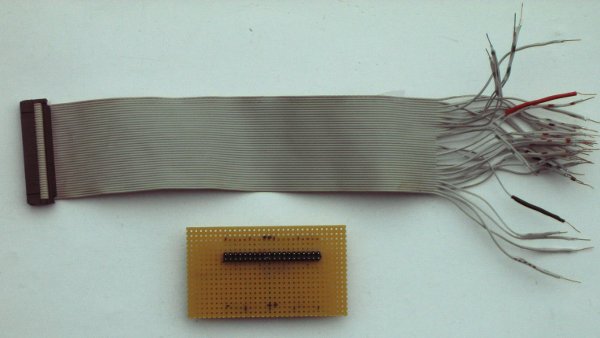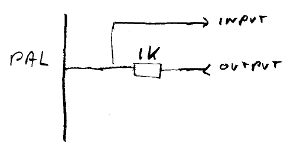
Inspired by the interesting blog of Chuck Guzis on reading and analysing PALs and HALs, I created this shield for my Sanguino board and some software (sketches in Arduino speak) to read some PALs I have.
The goal is to create a sketch for each type of HAL/PAL that results in a file that can be analysed, manually or by some smart program. Currently only the first part is being developed.
As HAL and PAL devices vary wildly in their pinout, no shield with a socket is used. Instead I use an experimenters board and a flatcable terminated with compatible pins. This means that for every type of PAL the reader has to be rewired, but for low volumes this is acceptible. It is also allows easy rearrangement of the pins.
Created so far are these sketches. Each sketch contains a rudimentary description of how the pins should be wired and the signals interpreted. The output is in text-binary (0s & 1s) format.
An example:
GAL16V8 read v1.1 B0, B1, B2, B3, B4, B5, B6, B7, A0, A1, C0, C1, C2, C3, C4, C5, C6, C7 1 2 3 4 5 6 7 8 9 11 12 13 14 15 16 17 18 19 IIN,IOUT,IA0,IA1,IA2,IA3,IA4,IA5,IA6,IA7,OACT,OC0R,OC1R,OC1W,OC2R,OC8FCS,ODBDR,O0 A0-A1,B0-B7 C0-C7 0000000000 1111111 0000000001 1111111 0000000010 1111111 0000000011 1111111 ...skipping some uninteresing stuff
... 1011111100 1111111 1011111101 1111111 1011111110 1111111 1011111111 1111111 1100000000 0111100 1100000001 1111111 1100000010 0111100 1100000011 1111111 1100000100 0110010 1100000101 1110110 1100000110 0111010 1100000111 1111111 1100001000 0101110 1100001001 1111111 1100001010 0101110 1100001011 1111111 1100001100 1111111 ...
Quite a lot of PALs have tri-state capable pins. To detect this, two pins of the microcontroller are used, as shown on the diagram, one as output, one as input.

By measuring the level at the PAL pin, both when pushing it high and pulling it low, a tri-state can be detected. If the pin follows the output, it is tri-state. If it remains stuck at one level it is an output. The PAL16R6 sketch has the tri-state detection. The current program does not try to detect the state itself, it just prints both levels. Note the difference between a tri-state output or 'buried' output pin and a input pin cannot be detected. Only if the analysis finds more terms are needed to describe the behaviour than would fit inside the PAL, some 'buried' outputs should be assumed.
Even some of the older PALs have pins that clocks a value in a register. For the PAL16R6 this happens on the transition from low to high. Every combination for the other input pins has to be checked in this order. Note it is not simple to find matching terms for registered PALs which also use 'buried' outputs.
Using this method to crack PAL based dongles is probably a waste of time.
Additional remarks:
Last update: 2012-09-17